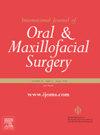诱发孤立性眶底骨折的尸体研究及其对手术决策的影响:两种术前成像模式的比较。
IF 2.2
3区 医学
Q2 DENTISTRY, ORAL SURGERY & MEDICINE
International journal of oral and maxillofacial surgery
Pub Date : 2024-10-04
DOI:10.1016/j.ijom.2024.09.005
引用次数: 0
摘要
计算机断层扫描(CT)是诊断孤立性眶底骨折的金标准,而锥束计算机断层扫描(CBCT)则是另一种选择。本研究旨在比较 CT 和 CBCT 对孤立性眶底骨折的诊断准确性。研究人员在尸体眼眶中系统地诱发了 48 处孤立性眶底骨折。对每个尸体头部进行 CBCT 和 CT 扫描,并将图像数据导入 ProPlan CMF 进行分析。对眶底面积(OFA)、眶缺损面积(ODA)和眶周组织疝进行了评估。不同成像模式的手术决策差异显著(P = 0.031)。在对眶周组织疝和骨折定位进行调整后,CBCT 和 CT 的决策差异几率随着 ODA/OFA 比率的增加而增加(P = 0.026)。在手术决策中,ODA/OFA 比值大于 36.25% 的临界值对预测 CBCT 和 CT 的差异具有 100% 的灵敏度和 71% 的特异性(曲线下面积 0.83,P = 0.011)。在这项尸体研究中,对于 ODA/OFA 比值≤36.25%的孤立性眶底骨折,CT 和 CBCT 的诊断效果相当。不过,对于超过这一阈值的骨折,最好还是通过 CT 进行评估,以避免手术决策出现偏差。本文章由计算机程序翻译,如有差异,请以英文原文为准。
A cadaveric study of induced isolated orbital floor fractures and implications for surgical decision-making: comparison of two preoperative imaging modalities
Computed tomography (CT) is the gold standard for the diagnosis of isolated orbital floor fractures, while cone beam computed tomography (CBCT) is an alternative. The aim of this study was to compare the diagnostic accuracy of CT and CBCT for isolated orbital floor fractures. Forty-eight isolated orbital floor fractures were systematically induced in cadaver orbits. CBCT and CT scans of each cadaver head were performed and the image data imported into ProPlan CMF for analysis. The orbital floor area (OFA), orbital defect area (ODA), and peri-orbital tissue herniation were evaluated. Surgical decision-making differed significantly according to the imaging modality (P = 0.031). The odds of decision discrepancy between CBCT and CT were higher with increasing ODA/OFA ratios, when adjusted for peri-orbital tissue herniation and fracture localization (P = 0.026). An ODA/OFA ratio cut-off value of >36.25% had a sensitivity of 100% and specificity of 71% (area under the curve 0.83, P = 0.011) for predicting discrepancies between CBCT and CT in surgical decision-making. In this cadaveric study, CT and CBCT were diagnostically equivalent for isolated orbital floor fractures with an ODA/OFA ratio ≤36.25%. However, fractures exceeding this threshold may be better evaluated by CT to avoid discrepancies in surgical decision-making.
求助全文
通过发布文献求助,成功后即可免费获取论文全文。
去求助
来源期刊
CiteScore
5.10
自引率
4.20%
发文量
318
审稿时长
78 days
期刊介绍:
The International Journal of Oral & Maxillofacial Surgery is one of the leading journals in oral and maxillofacial surgery in the world. The Journal publishes papers of the highest scientific merit and widest possible scope on work in oral and maxillofacial surgery and supporting specialties.
The Journal is divided into sections, ensuring every aspect of oral and maxillofacial surgery is covered fully through a range of invited review articles, leading clinical and research articles, technical notes, abstracts, case reports and others. The sections include:
• Congenital and craniofacial deformities
• Orthognathic Surgery/Aesthetic facial surgery
• Trauma
• TMJ disorders
• Head and neck oncology
• Reconstructive surgery
• Implantology/Dentoalveolar surgery
• Clinical Pathology
• Oral Medicine
• Research and emerging technologies.

 求助内容:
求助内容: 应助结果提醒方式:
应助结果提醒方式:


